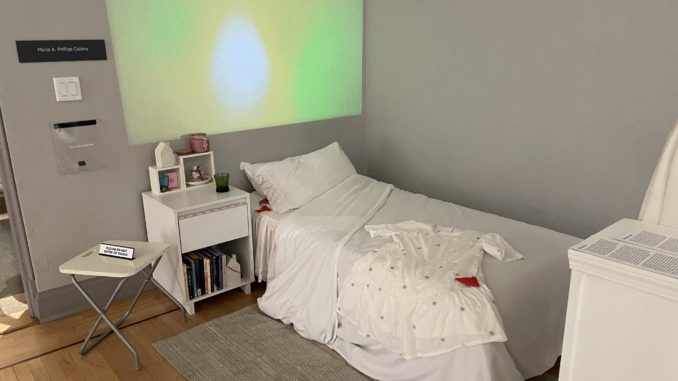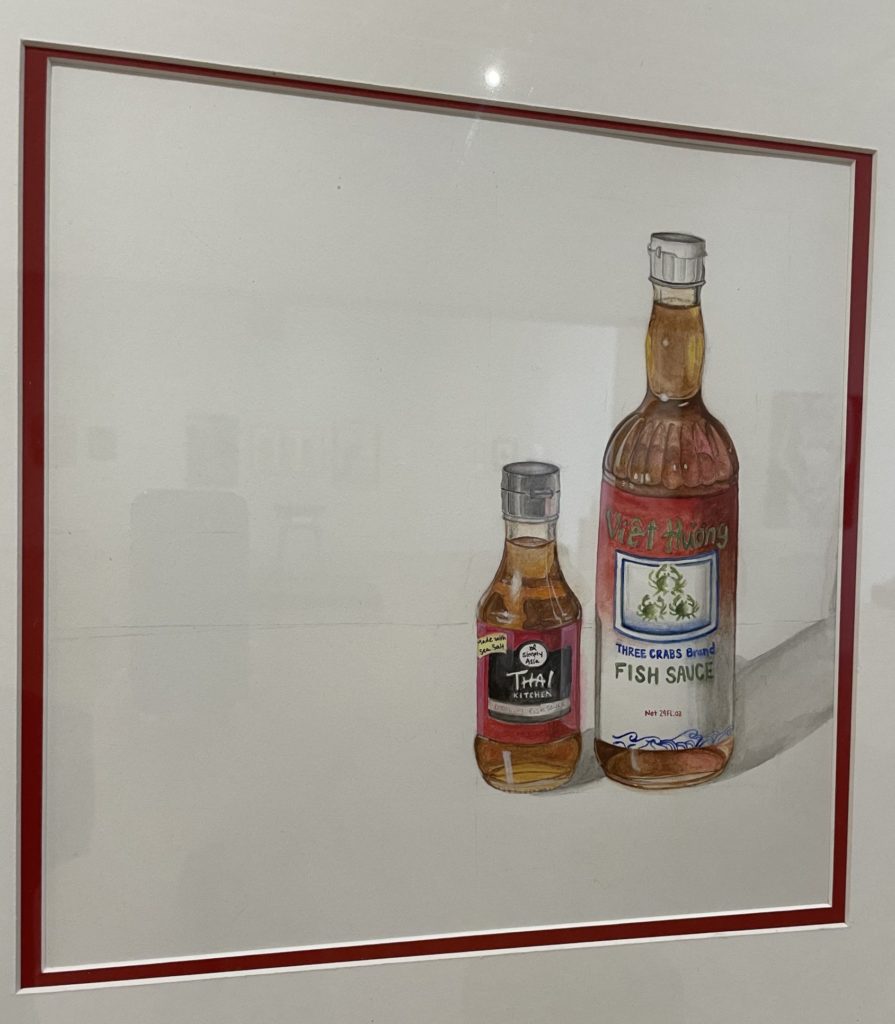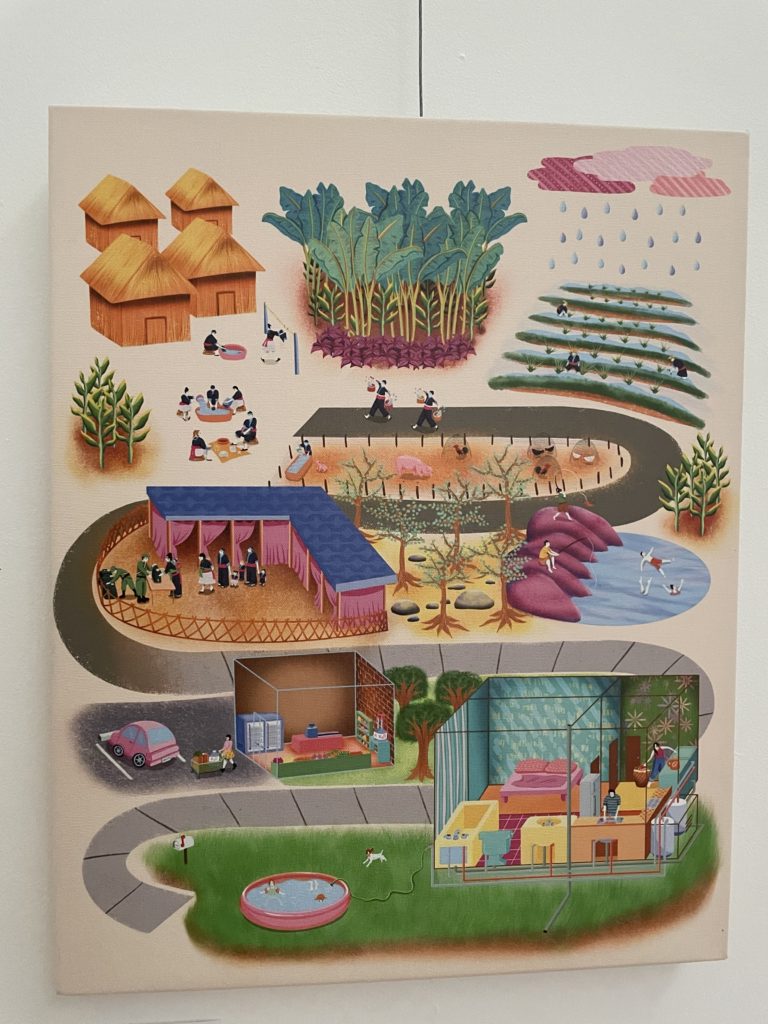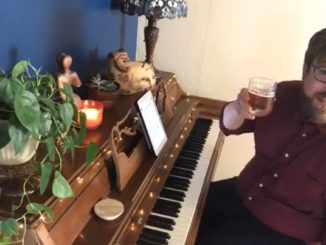
A closeup of an eye is projected large onto one of the gallery’s white walls as two fingers enter the video’s frame to pinch then pull the long eyelashes from their lids. It’s part of an appropriately uncomfortable opening scene to the video installation “Becoming” by flow-artist Der Her (aka Mage Flow).
In the accompanying description, she describes the piece as an exploration of the influence that Western beauty ideals—“blue eyes, double eyelids, fair-skinned, high cheekbones”—have had on Eastern cultures. After dropping the discomfort of the facade, the Hmong-American artist underneath emerges without makeup and is free to express her true self via a mesmerizing fire-and-hoop dance performance. Her’s video installation is illustrative of the mood of the rest of the current Museum of Northern California Art (MONCA) group exhibit No Word for Art, which weaves a thread of intimacy through very personal and often interactive pieces.
The show, subtitled “Contemporary Hmong-American Art in Northern California,” was co-curated by Elizabeth Lee and Stacey Lo; in a press release, Lee explains that the title refers to the challenge faced by young Hmong-Americans whose elders literally don’t have the language to understand their creative pursuits. The focus of the show is to, through art, start conversations about the complexities of Hmong-American identity.


In her own works, Lee—first generation Hmong-American—“is focused on the integration and progression of the Hmong culture into American culture.” For this show, she illustrates this via elegant gouache paintings of Asian market staples that have started making their way into American grocery stores, items such as Japanese Pocky cookie sticks (“$1.00, $1.49 (Pocky)”) and Vietnamese and Thai fish sauces (“$3.99, $4.99 (Fish Sauce)”).
Lee was also involved in a collaboration with the Hmong youth-empowerment program Leaders for a Lifetime for a series of “story cloths.” The project features embroidered representations of stories from the lives of the program participants (from junior high through college age) on a square of blue cloth. Some feature multiple snapshots from personal timelines, while others focus on one vision, such as “My Academic Journey” by Pa Zao Her, with its stitched squirrel hunt alongside a photo of a young boy carrying the day’s kill to the stock pot.
There are several interactive works in the exhibit that invite the viewer to take part. The most striking of these is the large “Xaws Ua Ke” (“Community Weaving”) display. A long section of chicken wire mounted to a blue wall is covered with colorful fabric strips that have—as the instructions direct—been woven in and out of the mesh at the viewers discretion.
In the same darkened room as the dance-performance video, co-curator Lo has installed a more passively interactive, and very intriguing, piece. “The Echo of Emotions is All That Remains After a Nightmare” is a full-scale model of a modest bedroom. A white dress with a red triangle of fabric (a wound?) pinned to it is laid across the white bed, and on the wall above is projected a video loop of abstract colors behind the text from the artist’s real-life nightmares (e.g., “If you call out your name, the ghost won’t touch you”). In the description, Lo says that a series of traumatic dreams triggered emotional and spiritual exploration that led her to seek out both Hmong and Western practices and guidance. Shamanism, dreams and the spirit realm were her inspirations for an installation that literally lets the viewer into her room to watch it all play out.

For the show, MONCA was awarded a $4,379 Humanities For All Quick Grant by California Humanities, a nonprofit partner of the National Endowment of the Humanities. The program “supports locally initiated public humanities projects that respond to the needs and interests of Californians, encourage[s] greater public participation in humanities programming, particularly by new and/or underserved audiences, and promotes understanding and empathy among all our state’s peoples in order to cultivate a thriving democracy.”
The biggest strength of this exhibit is it meets that “public participation” requirement. The Hmong community has definitely been underserved in local arts, and handing the curatorial reins over to those whom the exhibit represents makes for a very rich, authentic experience.
No Word for Art: Contemporary Hmong-American Art in Northern California shows through Sept. 26.
Upcoming programs:
Sept. 4, 5:30-7:30 p.m.: Paj Ntaub: Embroidering traditional Hmong art workshop. Tickets $20.
Call museum to reserve.
Sept. 10, 5:30-7:30 p.m.: Community art-making night. Free.
Sept. 19, 5:30-7:30 p.m.: Virtual artist panel/conversation. Visit site for details.
Museum of Northern California Art
900 Esplanade
487-7272
monca.org




Be the first to comment